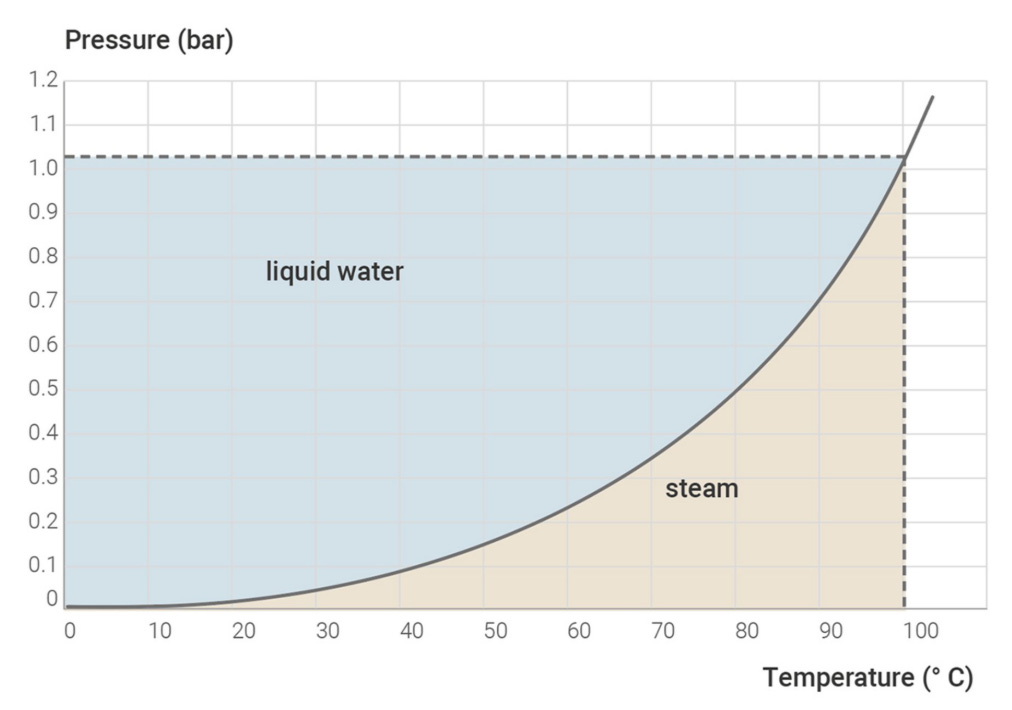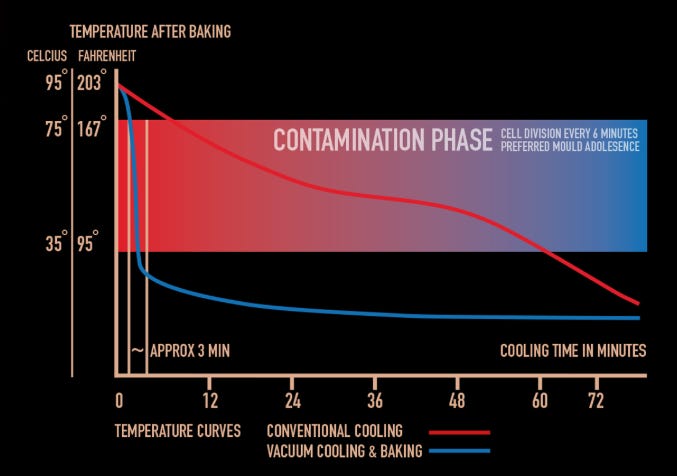Vacuum cooling has moved from a niche innovation to a strategic solution for industrial bakeries seeking faster throughput, tighter process control, and extended shelf-life. By using pressure reduction to trigger rapid evaporative cooling, this technology delivers measurable gains that conventional cooling simply cannot match.
1. Principle of Operation
When pressure decreases, the boiling point of water drops, allowing moisture inside the product to evaporate at much lower temperatures.
This phase change removes latent heat directly from the crumb and crust, resulting in exceptionally fast, uniform cooling.
2. Influence on the Baking Process
Vacuum cooling interacts directly with the physical and biochemical transitions of baked goods.
Crumb Structure and Volume
The rapid drop in pressure causes some of the moisture inside the product to flash into steam. This momentary expansion helps the crumb lift and settle into its final shape before any collapse can occur.
In laminated doughs, this effect encourages cleaner separation between layers and contributes to greater volume. In breads, it helps stabilize the structure that was formed during baking, reducing the shrinkage often seen during slow cooling.
Products with tighter crumb structures, such as soft sandwich bread or brioche, are more sensitive to rapid pressure changes. Their compact networks can tear if the vacuum is applied too quickly, so a gentler pressure curve is needed to protect the crumb and maintain stability.
Moisture Migration
Vacuum cooling quickly drives moisture from the crumb to the surface, where it evaporates almost instantly, leaving the crust noticeably drier and crisper.
To avoid over‑drying, baking time can be reduced or humidified air can be reintroduced during venting so that moisture is retained and crust texture is moderated.
Starch Gelatinization and Protein Denaturation
Vacuum cooling halts cooking instantly, stopping the carryover heat that would normally complete starch gelatinization and protein setting during slow cooling.
If the product enters the chamber under‑baked, some of these structures may remain partially unset, which weakens the crumb.
To ensure stability, the internal temperature must be high enough before cooling begins, and this is usually achieved by baking slightly hotter or slightly longer so the center reaches full gelatinization.
Final Product Quality
Vacuum cooling tends to produce a more uniform crumb and a cleaner, crisper crust because the structure is stabilized quickly and moisture is removed efficiently. The rapid cooling also reduces microbial growth by moving the product through critical temperature zones much faster than conventional cooling.
However, the same drying effect can create challenges in softer breads, where the crust may become too firm if moisture is not carefully managed. If excessive water is lost during the process, staling can also accelerate, making it essential to balance vacuum intensity, bake time, and venting conditions to preserve the desired texture.
3. Key Process Variables
Many factors influence vacuum cooling performance. Each one affects how efficiently heat is removed and how well the product structure is preserved, making proper control critical for both quality and throughput.
Vacuum pressure controls the rate of evaporative cooling. Most bakery products cool efficiently within 30–200 mbar, but the pressure must be reduced gradually to avoid sudden boiling that could damage the crumb.
Dwell time refers to the duration during which the product remains under vacuum. Most items stabilize within a few minutes, and extending the cycle can increase drying and weight loss without meaningful benefit.
Entry temperature influences cooling efficiency. When products enter the chamber at 90–98 °C, they contain enough available moisture to support rapid evaporation.
Moisture content and structure affect how the product responds. High‑hydration doughs cool more effectively, while denser products require gentler pressure curves to avoid internal stress.
Pressure curve design and venting conditions help protect the product. Multi‑stage curves reduce structural damage, and humidity during venting can prevent excessive crust drying.
Equipment capacity and loading shape overall performance. Overloaded chambers restrict vapor escape and cause uneven cooling, while single‑layer spacing supports consistent results.
4. Advantages and Challenges
Advantages
Vacuum cooling sharply reduces the cooling phase, cutting it to just a few minutes. This time saving:
Boosts line throughput
Lowers work‑in‑process inventory
Removes a major production bottleneck without requiring extra floor space.
Reduces energy use
Improves crumb consistency
Minimizes post‑bake collapse
Limits microbial growth and allows earlier packaging, helped by a drier crust that can delay mold development.
Challenges
The initial investment is significant because chambers, pumps, and condensers are costly and may require facility upgrades.
Operating expenses can increase due to pump maintenance and the need for trained operators who understand pressure control.
Moisture loss of 2–5% is common and may require adjustments in dough hydration or scaling.
The method is unsuitable for dense cakes, fillings, or delicate structures that cannot tolerate rapid moisture evaporation.
Process and recipe adjustments are required to ensure products are fully set before cooling begins.
Because vacuum systems operate in batches, integrating them with continuous oven lines may require multiple chambers to maintain throughput.
Cost and ROI
While the upfront investment is considerable, vacuum cooling can provide an attractive return for medium‑to‑large bakeries. Costs stem from the equipment itself, ongoing pump operation, maintenance needs, and potential facility modifications.
The payback, however, is driven by increased productivity, reduced energy consumption, lower waste, and improved shelf‑life. Many industrial bakeries operating in continuous or multi‑shift environments achieve full ROI within one to three years.
👉 Thanks for reading! 💬 Any experiences to share with us?? – We’d love to hear your story!
Sources: www.vacuumcooling.com
www.ireks-kompendium.com
https://tinyurl.com/mw627584












